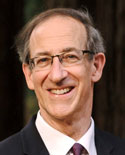Awardee Interviews | Biography: Tony F. Heinz
Tony F. Heinz
 Tony F. Heinz
Tony F. Heinz, Stanford University,
“For seminal contributions to the field of 2D materials, including the ground-breaking discoveries of the distinctive electronic and optical properties of atomically thin two-dimensional semiconductors”
Tony Heinz received a BS degree in Physics from Stanford University in 1978 and a PhD degree, also in Physics, from the University of California at Berkeley in 1982. Heinz then joined the IBM Research Division in Yorktown Heights, NY as a research staff member. In 1995, he became a professor of Physics and Electrical Engineering at Columbia University. In 2015, he joined Stanford University as a Professor of Applied Physics and SLAC National Accelerator Laboratory as a Professor of Photon Science. At SLAC, he is currently serving as the Associate Laboratory Director for Energy Sciences.
Heinz has been involved in leadership of several large-scale research centers, including as a Scientific Director of the Columbia Nanoscale Science and Engineering Center funded by the National Science Foundation and of the Columbia Energy Frontier Research Center funded by the US Department of Energy. In 2012, Heinz served as President of the Optical Society of America. He is a Fellow of the American Physical Society, the Optical Society of America, and the American Vacuum Society. He is the recipient of the Optics Prize of the International Commission for Optics, the Julius Springer Prize for Applied Physics, the Senior Scientist Research Award from the Alexander von Humboldt Foundation, the Frank Isakson Prize of the American Physical Society, and the William Meggers Award of the Optical Society of America.
Heinz has made seminal contributions to the understanding of surfaces, interfaces, and nanoscale materials through the development and creative application of spectroscopic techniques. His early contributions to optical second‐harmonic generation helped to launch this sensitive method for probing surfaces and interfaces. His application of femtosecond lasers provided impetus for the creation of the vibrant field of ultrafast surface dynamics. His development of time‐domain THz spectroscopy greatly expanded the method’s reach and impact; and his creation of several new methods of probing nanomaterials has strongly influenced this broad field of research. The creative application of these methods has been equally significant, and Heinz has been a world leader in revealing the unique electronic and optical properties of 1D and 2D materials. Among his most influential discoveries are the demonstration of excitons in carbon nanotubes and of the quantized optical absorbance in graphene. His work on 2D semiconductors has been broken new ground. His research group and collaborators discovered the emergence of transition-metal dichalcogenide monolayers as direct‐gap semiconductors and demonstrated new properties and functionality in 2D semiconductor heterostructures, sparking the development of one of today’s largest area research in 2D materials.
Heinz is known as a dedicated educator and enjoys teaching students from introductory physics classes to specialized graduate courses. At Columbia, his contributions were recognized by the University’s Great Teacher Award. He takes particular pride in the accomplishments of his more than eighty former graduate students and postdocs who are expanding the frontiers of science and technology around the world.